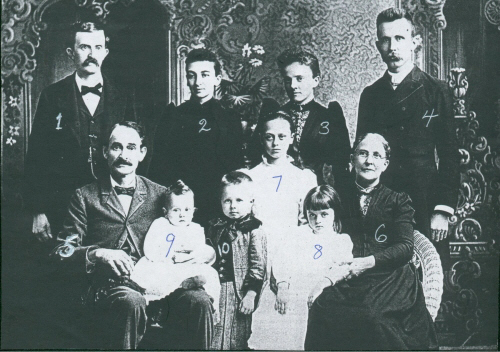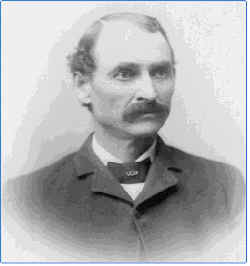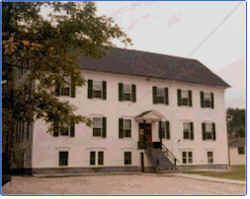|
| |
Ancestors
and Descendants
1800s - Present
Unfortunately,
I have neither photos nor memories of my father's
ancestors. My grandfather, George W. Hildreth died in
1877, 46 years before I was born and Grandmother Elvira
died in 1881. It seems that pictures of them and any of
their direct ancestors do not exist and, to my regret, we
have very few pictures of my father and none taken of him
and me together. Either he was busy taking the pictures
or he was not present when pictures were being taken.
Fortunately, we have a considerable number of photos of
my mother at various ages from the 1880s to 1970 and also
there were photos of some of her ancestors which have
been passed on to me. The pictures in the latter part of
the 19th century and the early years of the 20th century
were taken by professional photographers and the subjects
were posed in very formal and stiff fashion. Amateur
photography wasn't possible or popular until after 1889
when George Eastman invented roll film and cameras that
were simple to operate came into being. My hope is, that
among those of you who may view these photos, some of you
will be prompted, for nostalgic or other reasons, to
search for photos of your family and present them as a
historical record to be observed, enjoyed and preserved
by your descendants.
|

Mother's Paternal Family

|
My Mother-to-Be, Mary Adams
With Sibs and Paternal Family
7. Mary Adams; 1 Grandfather,
Fred Eugene Adams; 2 Grandmother Lizzie Moors Adams; 5
Great-grandfather Alphonso Adams and 6 Great grandmother
Mary Rider Adams (2nd wife of Alphonso); 3
Fred’s sister Lilla and 4 her husband Will Hardy; 8
Mary’s sister Elgie Adams; 9 Mary’s brother
Carroll Sidney Adams; 10 Child of Lilla and Will Hardy.
|

 |
Alphonso A.
Adams born in Jaffrey, NH
on November 13,1834 and moved to Marlborough,
NH in1854. He married on January 22, 1857
Mary E. Cutter, daughter of John A. and Nancy
(Wheelock) Cutter. They had two children,
Fred E. (my grandfather) and Lilla.
|
| Alphonso was a Civil War veteran
and was wounded while serving as a member of
Company C, 14th regimentNew Hampshire
Volunteers. The only belonging of his that I
possess is the cane given to him upon discharge
from the hospital after he was wounded. He was a
civic-minded individual having been elected to
the school board in 1882 and in 1883 was elected
as Selectman of Marlborough, NH (population
probably 1,200-1,500 at that time). Selectmen
were and, as of this writing, still arethe
equivalent of City Council members in larger
cities. |
 |
Alphonso also was a carpenter
and built many of the houses in Marlborough as well
as the TOWN HALL and the SCHOOLHOUSE
(pictured to the left) in the 1870s or 80s.
This is the school that my 4 sibs and I
attended, Claire being the oldest started in
1910 and I was in the class of 1941.
|
| |
Two of my nieces also
attended here graduating in1943 and 45. My sibs
went from 1st grade through high school in the
building and my class was the first to begin with
the 2nd grade. Graduating classes
normally had 20-30students but mine had only 10.
Eventually, several area high schools
consolidated and a large high school was built. A
new school was built for grades one through eight
after which the old school building was converted
to an apartment building.
The TOWN HALL was similar to the HIGHSCHOOL being
of frame structure with clapboard siding. As in
many small towns, it was built as a
multifunctional facility. On the 1st
floor it had a grocery store and a meat market. A
central stairwell between the two stores lead up
to a lobby with an office for Selectmen on one
side and stairs leading to the third floor Grange
Hall on the other side. The rest of the floor to
the rear of the building was dedicated to an
auditorium which was multifunctional serving as a
theater, silent movie theater, dance hall, Town
Meeting Room, donkey basketball court and
basketball court for our high school basketball
teams. The court was not regulation size and had
out-of-bounds lanes about only a foot wide. At
one end was the stage and frequently one going in
for a lay-up basket might land on the stage. At
the other end swinging doors opened onto the
lobby so occasionally one of us charging in to
make a basket might run out the doors into the
lobby. At times it would take a while for the
player to return. Also, the game was different.
There was a jump ball after every basket and four
8 min. quarters so the scores were usually in the
30s or 40s. And, girls basketball! They could
only play half-court games, not being permitted
to cross the center line. Therefore, there were
six players per team - a center and two forwards
who were allowed to score and three guards trying
to keep the opponent forwards and center from
scoring. Thus, there were always six players on
either side of the center line, six playing and
six not. Strange!
|
| |
|
|
|

An Ongoing
Project ... Visit Again Soon!


Page Updated: 09OCT00
Philip E. Hildreth
|
![]()